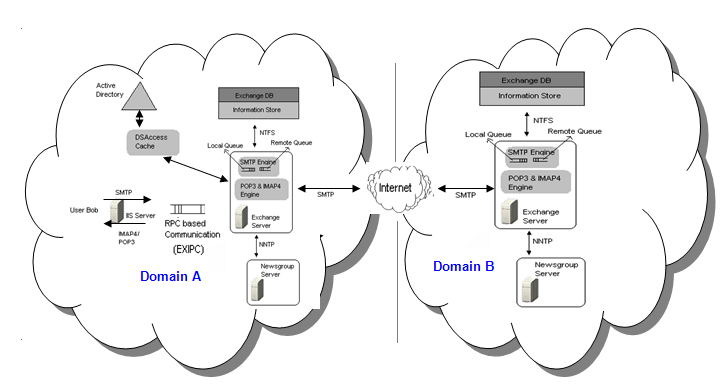Introduction
Microsoft's Exchange 2000/2003 server is an enterprise messaging system that is tightly integrated with the Windows 2000/2003 operating system. Figure 1 shows how the Exchange 2000/2003 Server interacts with the Internet Information Server and Active Directory within a domain. This figure also depicts how an Exchange 2000/2003 Server belonging to one domain communicates with another Exchange 2000/2003 server on another domain. The Simple Mail Transport Protocol (SMTP) is the primary protocol used by the Exchange server for sending e-mails and connecting to another Exchange server that are available in other domains. An user connecting to the Exchange server uses SMTP to send and Post Office Protocol (POP3) or Internet Messaging Access Protocol version 4.0 (IMAP4) to receive e-mails from the mailbox. SMTP, POP3, and IMAP4 are all implemented using virtual servers in the IIS server. Alternatively, clients also use MAPI which is based on remote procedure calls to communicate with the Exchange server.
Since IIS and Exchange servers run in separate address spaces, an RPC based communication layer is necessary to forward the requests to the corresponding mail protocol engines which are residing on the Exchange server. This layer is called the Exchange InterProcess Communication Layer (EXIPC).
The Exchange 2000/2003 Server internally uses two queues namely, the local queue and the remote queue. The local queue is meant for sending e-mails to users belonging to the same domain. The remote queue is used for sending e-mails to users of other domains.
The Exchange server stores all the e-mails in a repository called the Exchange Database. The server uses NTFS to connect to the Exchange Database. The user e-mail address and credentials are stored in the Active Directory. The Exchange server uses a cache (called the DSAccess cache) to avoid frequent accesses to the Active Directory service.

Figure 1 : Architecture of a Microsoft Exchange server
The Exchange server uses Network News Transport Protocol (NNTP) to communicate with Newsgroup servers. NNTP is also implemented using a virtual server in the IIS server.
Since the Exchange server relies on Windows 2000/2003 Active Directory, Internet Information Services and Domain Name System, the Exchange server administrators need to be more proactive than reactive to ensure that critical messaging services remain available to the customers and end-users. One of the most common complaints that Exchange administrators receive from users is that of slow mail performance. The key challenge for an administrator here is to determine where and why a slow-down is occurring (e.g., is there a problem is receiving data from clients over a network? is the slow-down in the Exchange server's processing? or is the problem due to slow disk read/writes at the operating system level?), and what can be done to solve this problem. This is where eG Enterprise lends helping hands to Exchange administrators to determine and address the issues in Exchange server performance at the earliest.



